Learning Kofta
 As I have mentioned before, Morganna is taking a class called “World Foods” at school which is a clever way to get kids to take Home Economics, learn to cook, and learn about other cultures all at the same time. It is a pretty good class, and the kids get to cook and eat foods from the countries that they voted on learning about at the beginning of the class. Each student also chooses a country to do a final project on that will include a written and oral report, a physical cultural display about the country, culture and cuisine, and a sample dish cooked from that cuisine.
As I have mentioned before, Morganna is taking a class called “World Foods” at school which is a clever way to get kids to take Home Economics, learn to cook, and learn about other cultures all at the same time. It is a pretty good class, and the kids get to cook and eat foods from the countries that they voted on learning about at the beginning of the class. Each student also chooses a country to do a final project on that will include a written and oral report, a physical cultural display about the country, culture and cuisine, and a sample dish cooked from that cuisine.
Morganna chose India, so from now one, each week, we will cook at least one Indian meal. The last time we did this, Morganna learned how to make masoor dal tarka; this time, she learned how to make lamb kofta. We decided to add the greens directly to the dish to make saag kofta, which is very like the palak kofta I learned from my Pakistani friends.
“Palak” means spinach; “saag” is a general term which means “greens.” In most Indian restaurants in the US, if you see “saag gosht” it technically means “meat cooked with greens,” but usually it is meat cooked with spinach. The only other greens I have had in a restaurant have been fenugreek greens, in which case, the specific term, “methi” is used in the title of the dish.
Kofta can be made of minced meat or vegetables; I decided to start with minced lamb kofta, because the meat is easier to work with for a beginner. Interestingly, the word, “kofta” is from the language of the Persians who conquered the northern part of India centuries ago. It is the same exact word that is used in Iranian cuisine when describing similar meatball dishes. Much of the cuisine of northern India is related to Persian foods and so there is a great correlation between the foods of the near east and the Indian subcontinent.
Whether they are made of meat or vegetables, I learned that the best kofta are very light, and tender in texture; they are nothing like the tough, sometimes rubbery meatballs that are often served in the west. I learned the trick of how to make light kofta from one of my client’s mothers–she said to never pack the meat down tightly and to handle the kofta as little and as gently as possible when shaping them and when browning them, to move them as gently as possible, as the minced lamb ones do not have any binder in them at all. (This also makes them tender.)
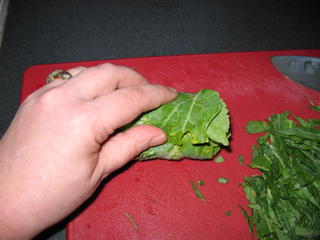 One of the keys to making good Indian food is to be relaxed and do good prep work; precision is almost as important in Indian cookery as it is for Chinese food. In order to present the greens well, they should be minced, shredded or ground in some way; I chose to cut them in a chiffonade–long, narrow ribbons which look pretty and make an easily eaten dish when cooked. The simplest way to cut the greens this way is to prepare the collards for cooking in the usual way: wash and drain them thoroughly, then tear out the tough central vein. Stack the leaf pieces up neatly, the roll up tightly like a big fat cigar.
One of the keys to making good Indian food is to be relaxed and do good prep work; precision is almost as important in Indian cookery as it is for Chinese food. In order to present the greens well, they should be minced, shredded or ground in some way; I chose to cut them in a chiffonade–long, narrow ribbons which look pretty and make an easily eaten dish when cooked. The simplest way to cut the greens this way is to prepare the collards for cooking in the usual way: wash and drain them thoroughly, then tear out the tough central vein. Stack the leaf pieces up neatly, the roll up tightly like a big fat cigar.
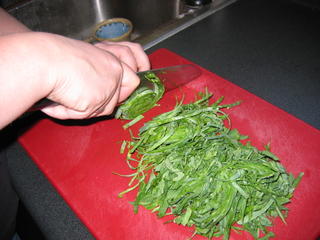 Lay the roll seam side down on the cutting board and then cut as narrow slices of it as possible. These coiled slices will unfurl into tiny green ribbons that look beautiful and cook in the curry sauce quite quickly. This chiffonade technique can be used with any leaves, from large cabbages to basil to Thai kaffir lime leaves. All that is needed is patience, a sharp knife and nimble fingers, and the hard work pays off–chiffonade makes a lovely presentation of cooked greens, of raw lettuces in a salad or as a garnish sprinkled over a soup or sauce.
Lay the roll seam side down on the cutting board and then cut as narrow slices of it as possible. These coiled slices will unfurl into tiny green ribbons that look beautiful and cook in the curry sauce quite quickly. This chiffonade technique can be used with any leaves, from large cabbages to basil to Thai kaffir lime leaves. All that is needed is patience, a sharp knife and nimble fingers, and the hard work pays off–chiffonade makes a lovely presentation of cooked greens, of raw lettuces in a salad or as a garnish sprinkled over a soup or sauce.
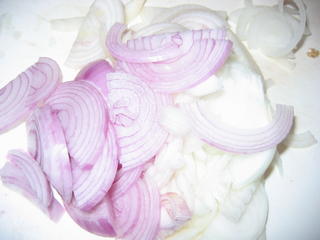 Another necessity for careful preparation when cooking Indian foods is to slice the onions very thinly. The reason for this is that in Indian cookery, particularly the cooking of the northern part of the country, it is crucial to brown the onions very well; they should be a dark golden-reddish brown when they are done. If you slice the onions too thick, then they take a long time to brown, and sometimes, because American onions are so juicy, they may not brown at all. So, I always try and cut them so thin that you can see through the slices. Morganna didn’t do too badly at it, as you can see on the left. The purple ones are very pretty–it was almost a shame to cook them up! I almost felt that we should have made a dish to use them raw just to keep the lovely transluescent pearly violet color.
Another necessity for careful preparation when cooking Indian foods is to slice the onions very thinly. The reason for this is that in Indian cookery, particularly the cooking of the northern part of the country, it is crucial to brown the onions very well; they should be a dark golden-reddish brown when they are done. If you slice the onions too thick, then they take a long time to brown, and sometimes, because American onions are so juicy, they may not brown at all. So, I always try and cut them so thin that you can see through the slices. Morganna didn’t do too badly at it, as you can see on the left. The purple ones are very pretty–it was almost a shame to cook them up! I almost felt that we should have made a dish to use them raw just to keep the lovely transluescent pearly violet color.
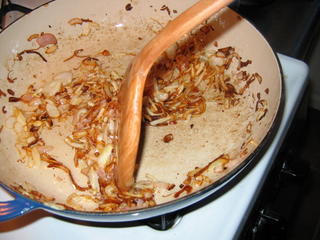 Browning the onions in oil or ghee takes a heavy pan on medium heat (we used the Le Crueset skillet), some salt, a good stirring implement and patience. If you turn the heat up too high, you risk burning the onions, and once they are burnt, you cannot undo it. You must throw them away, clean out your pan and start over. And since proper browning takes fifteen to twenty minutes–you really don’t want to start over. But, I predict that you will likely burn a pan of onions at least once. The phone will ring and you will turn away to answer it, or a cat or child will drag your attention away for a few moments, and when you turn back, the onions will have gone from dark golden to perfect mahogany to black in mere seconds. (Yes, they can go wrong just that quickly. I have burned onions at least twice that way.)
Browning the onions in oil or ghee takes a heavy pan on medium heat (we used the Le Crueset skillet), some salt, a good stirring implement and patience. If you turn the heat up too high, you risk burning the onions, and once they are burnt, you cannot undo it. You must throw them away, clean out your pan and start over. And since proper browning takes fifteen to twenty minutes–you really don’t want to start over. But, I predict that you will likely burn a pan of onions at least once. The phone will ring and you will turn away to answer it, or a cat or child will drag your attention away for a few moments, and when you turn back, the onions will have gone from dark golden to perfect mahogany to black in mere seconds. (Yes, they can go wrong just that quickly. I have burned onions at least twice that way.)
Basically, you heat your oil or ghee until it is quite hot, and then put the onions in a single layer, and start stirring. When the first bits of juice are coaxed out–about two to three minutes into the cooking process, I sprinkle a bit of salt–no more than a half a teaspoon or so over them. The salt draws more of the water out of the onions, and as it boils away, that allows the browning process to begin. Keep stirring, and do not stop. It helps if you have music on so you can sing, or maybe dance in front of the stove while you do this. Morganna and I practiced belly dance hip thrusts and rolls while cooking the onions.
When the onions turn golden, start paying particular attention. They will have shrunk down in volume a great deal–much of an American onion is water after all, and after they turn distinctly golden, they will very quickly darken. They will turn dark gold, then reddish gold. You will be tempted to take them from the heat then, but wait until they are reddish brown or mahogany colored to turn off the fire, and quickly scrape the onions into a waiting bowl. Do not hestitate! If you leave them on the heat for just a few more seconds, they are likely to blacken and turn into an acrid, bitter mess that will destroy the flavor of both the kofta and the curry sauce, as the onions are used to flavor both.
The dark brown onions are important, not only because they give a special flavor to curries, but also because they are a component in coloring them as well. An Indian friend told me that she could always tell when an American had made Indian food because they never browned the onions deeply enough, so the curries tasted one-dimensional, and were weakly colored.
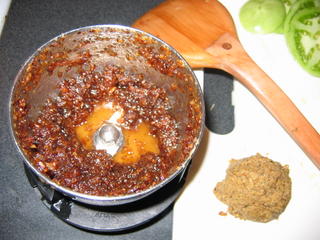 After they cooled, we put the onions into the Sumeet grinder and ground them into a thick, sweet-smelling dark red paste. The volume at this point has reduced by three-quarters the original volume. If you ever look at Indian recipes and they seem like they have way too much onion in them, this is why–they are cooked down to a very concentrated color and flavor–the browned essence of onion, if you will.
After they cooled, we put the onions into the Sumeet grinder and ground them into a thick, sweet-smelling dark red paste. The volume at this point has reduced by three-quarters the original volume. If you ever look at Indian recipes and they seem like they have way too much onion in them, this is why–they are cooked down to a very concentrated color and flavor–the browned essence of onion, if you will.
After they are ground up, the onions are portioned out; one third of them go into the kofta, and two thirds of them are set aside for the curry sauce. Pictured next to the onions, you can see the ball of curry paste that we made for the sauce: a mixture of ginger, garlic, fresh red Thai chile, cumin, coriander, black pepper, black cardamom and cinnamon. As in the onion paste, one third of the spice paste was gently kneaded into the kofta, along with about a half teaspoon of salt, while the rest was saved for the curry sauce.
 Shaping the kofta is another crucial point in the recipe; if you handle the meat mixture too much or too roughly, packing the kofta as you portion or shape them, they will toughen and will lose their delicate texture. Pictured at the right, you can see Morganna carefully portioning the meat out into rough ball shapes with a cookie scoop. Using a one-tablespoon volume scoop, she lightly presses a level amount into it, the squeezes the lever, releasing. She portioned out all of the meat before we began the process of shaping the kofta.
Shaping the kofta is another crucial point in the recipe; if you handle the meat mixture too much or too roughly, packing the kofta as you portion or shape them, they will toughen and will lose their delicate texture. Pictured at the right, you can see Morganna carefully portioning the meat out into rough ball shapes with a cookie scoop. Using a one-tablespoon volume scoop, she lightly presses a level amount into it, the squeezes the lever, releasing. She portioned out all of the meat before we began the process of shaping the kofta.
Some kofta are shaped round like typical meatballs, while others have sausage shapes. The ones I like to make are egg-shaped, or ovoid. I start by smoothing the rough portions into balls by lightly rotating them between my palms. To keep the meat from sticking, I dampen my palms with water. To shape the spheres into eggs, I roll them back and forth gently a couple of times between my palms.
 At no time do we compress the meat, and so the end result is a very light, very tender meatball that is filled with juice and flavor. Minced chicken is also very good cooked and shaped in this way, though, of course, I would use different spices in the paste for that.
At no time do we compress the meat, and so the end result is a very light, very tender meatball that is filled with juice and flavor. Minced chicken is also very good cooked and shaped in this way, though, of course, I would use different spices in the paste for that.
Fresh herbs can be added to the spice paste, and of course, the spices themselves can be changed to reflect personal tastes. Sometimes, I add more chile, and sometimes I like to add fresh mint, minced finely. Cilantro is also good, and I really like a bit of fenugreek greens, but they are impossible to get fresh here in Athens.
Once the kofta are shaped, the next hurdle is browning them–this takes a heavy pan (non-stick is great for this) a light touch, patience and nerves of steel. Morganna quickly became frustrated with trying to gently turn the kofta so they could brown evenly without breaking them apart. Once the browning is done and the liquid is added to start the curry sauce and to poach the kofta to complete doneness, the process becomes simple: add the sauce ingredients and allow the liquid to reduce until it forms a clinging sauce, then enrich it further with a bit of half-and-half or cream and an extra dollup of full-fat yogurt.
Served with turmeric colored basmati rice with a sprinkling of minced fresh mint with fried green tomatoes on the side, the saag kofta were a wonderful supper. Morganna took the leftovers with her to school, and shared them with her friends, all of whom were quite enthusiastic in their liking of them.
Perhaps this weekend, I will teach her how to make aloo methi, (potatoes with fenugreek greens), if I can pick up some fresh fenugreek in Columbus tomorrow.
The recipe looks more complicated than it is–or rather, it is more difficult to write it out in a detailed way, than it is to make. I haven’t used a recipe in years to make different kinds of kofta, but neither have I bothered to write down how I do it, either. It wasn’t until writing this post that I realized how daunting a process making a simple curry of meatballs and greens might seem to someone reading this.
Now I understand why I was so intimidated by Indian food for so many years. It is second nature to me now, but when I took my first steps toward serious study of it, I was certain I would never be able to cook without referring constantly to a cookbook. Now, I am much more comfortable with it.
I just hope that my detailed posts don’t scare people away from trying to cook Indian food themselves.
 Saag Kofta (Lamb Meatball Curry with Greens)
Saag Kofta (Lamb Meatball Curry with Greens)
For the Greens:
1 pound collard greens, washed and trimmed, with the thick vein removed.
Method:
Cut the greens into a 1/8 inch chiffonade as described and illustrated in the body of the post. Set aside until it is time to add them to the sauce.
Ingredients for the Curry Paste:
1″ cube fresh ginger, peeled and sliced
5 cloves garlic, peeled and sliced
2 or 3 fresh red Thai chiles (or to taste)
1 tablespoon toasted cumin seeds*
1 tablespoon toasted coriander seeds
1 black cardamom pod
1/2 teaspoon black peppercorns
Method:
In a mortar and pestle, a food processor, blender or food grinder like the Sumeet (I love the Sumeet–if you cook Indian, Thai and Mexican food, you need to get one), grind the spices into a thick, damp paste. If you use a blender and have to add water, add as little as possible.
Separate out the curry paste into thirds by rolling it into a ball, then into a log. Cut the log into three pieces, and set one aside, and squish the remaining two together.
Ingredients for the Onions:
1 large or 2 medium onions, sliced as thinly as possible
1/2 teaspoon salt
1 1/2 tablespoons vegetable oil or ghee (I used canola oil for this recipe)
Method:
Follow the instructions in the body of the post to cook the onions and grind them.
After they are ground, scoop out one third of the very thick, liquidy paste, and add to the one third of the curry paste. Save the remaining two thirds of the onions to go with the two thirds of the curry paste in the sauce.
Ingredients for the Kofta:
1 pound ground lamb
1/3 of curry paste
1/3 of browned onion paste
1/2 teaspoon salt
4 tablespoons oil or ghee
Method:
Pat the meat out into a thin, flat layer in a bowl or on a cutting board. Mix together the onion paste with the curry paste and salt until a thin paste is formed and spread this over the meat, then carefully roll the meat up or fold it up. Then, gently knead the meat mixture together using as little pressure as possible to mix it thoroughly and evenly.
Shape the kofta as directed in the body of the post.
Heat oil or ghee over medium heat in a heavy-bottomed pan or skillet (nonstick is great, especially for the first time or two you cook this recipe) that is big enough to hold all of the kofta, the greens and the sauce.
Set all of the kofta into the pan, and gently turn them as they brown by either shaking the pan or very carefully turning them with a spatula. Be very gentle or the tender kofta will fall apart. (Probably the first couple you try to turn by hand will crumble, but you will quickly get the knack of it–it just requires a light touch and precision. Morganna learned it quickly–so can you.)
When the kofta are well browned on all sides, commence with making the sauce, and bringing it all together.
Ingredients for the Curry Sauce:
Reserved curry and onion pastes
1 cup chicken or vegetable broth (traditionally water or milk is used here, but I like the flavor the broths bring to the sauce)
1 cup full fat yogurt, cream layer removed and reserved
1/2 teaspoon ground turmeric
1/4 teaspoon paprika (I discovered that smoked Spanish paprika adds a nice flavor)
Prepared collard greens
1/4 cup cream from yogurt
1/4 cup half and half or heavy cream
salt to taste
handful fresh mint leaves, minced
Method:
After the kofta are cooked, turn down heat, tilt pan and spoon out about half the fat. Return pan flat to the burner and add onion and curry paste and, stirring carefully to avoid breaking the kofta (once the brown crust forms on them, they are a bit less fragile and are easier to handle), cook the pastes until they are very fragrant, about two minutes. Pour in the broth, and scrape up any browned bits at the bottom of the pan.
Stir yogurt, and add to the sauce, stirring to combine. Add the turmeric and paprika. Turn down the heat, and allow to simmer until the sauce has begun to reduce. Add the collards, sprinkling them over the kofta, and stirring them down into the sauce. Continue simmering uncovered until the sauce reduces almost to nothing.
Add the cream layer from the top of the yogurt container, and the half and half or cream, stirring it into the sauce. Taste and correct seasoning as needed with salt.
Sprinkle with mint before serving.
8 Comments
RSS feed for comments on this post.
Sorry, the comment form is closed at this time.
Powered by WordPress. Graphics by Zak Kramer.
Design update by Daniel Trout.
Entries and comments feeds.



Have I ever mentioned how much I love good lamb? Yummmm
This looks wonderful! Have fun in Columbus this weeekend!
Comment by Kate — October 7, 2005 #
As always, great and thorough instructions! I see you used our favorite kitchen gadget, the Sumeet. I thought you might be interested to know that I’ve read that traditionally, Kasmiri cooks used what we call collard greens, which grow along Dal Lake. I’ve had great results also with mustard greens, another traditional choice.
Comment by Brett — October 7, 2005 #
This really does look good, Barbara! (even though it’s ground lamb) Cool idea to use collard greens.
I too love fenugreek greens and I bet aloo methi would be fabulous. I first had methi when we made Dhansak (after consulting a recipe for the Parsee chicken and lentil dish from Bombay in ’50 Great Curries of India’ by Camellia Panjabi).
-Elizabeth
Comment by ejm — October 7, 2005 #
Barbara, you should write a cook book. Great job as always!
I love kofta curries.I make them with malai(paneer), plantain and potatoes usually for get togethers with friends. Little bit time consuming but kofta curries are worth the effort.
Congrats to Morganna for trying out this recipe. Is she thinking of making any traditional Indian sweets?
Comment by Indira — October 7, 2005 #
Pretty soon you will be able when you hear the whine “What’s for dinner?†You can answer,
“I don’t know. What are /YOU/ cooking?â€
Seriously, pass the congrats to the kidlette and let her know I am searching for something “unique†for handle materials. She will understand 🙂
Comment by Bryian — October 7, 2005 #
Thanks, Kate! The recipe looks more complex than it is–once you start going, and get the hang of it–it is worth the trouble.
We only went to Columbus to buy a stove. We bought the appliances, but only have a piece of paper until they come in six weeks.
The cabinets come the day before my birthday, though! Woohoo!
Brett–Thank you for telling me that–I knew that mustard greens are often used in India, but I also figured I would have no chance of getting those past Zak, so I thought I would use the collards and just not worry about authenticity. Turns out–it was still authentic! Excellent!
Elizabeth–aloo methi is one of my favorite potato dishes of all time. (Next to samosas, of course.) Aloo methi–wow. It is just so darned good. I love the fragrance of the dried methi leaves; I combine them with fresh methi and ground fenugreek seeds to the get the fullness of the flavor and aroma. To me it is like being in a field of ripe hay at midsummer–it is a very evocative fragrance. Add that to the earthiness of potatoes and garlic with a zip of chile and ginger, and I am in heaven.
Thank you Indira–your words mean a great deal to me.
I do like malai kofta–the texture is so comforting and rich. I have never made them, though–I should try it some time. Then Morganna can make cheese from scratch–that is great fun!
She may try to make some sweets, but she doesn’t think she can get her classmates to eat them, because she is afraid they would think they were too weird. We are probably going to do a biryani–rice and chicken–how scary is that to country kids who have never had Indian food in their lives? (Though, I think that anyone who didn’t like kheer would have to be nuts–that is what I suggested she make.)
Bry–I will pass on the congrats–she is getting better in the kitchen, though browning the kofta started to get on her nerves because they are so hard to turn gently without breaking them.
And I will also give her your message. 😉
Comment by Barbara Fisher — October 7, 2005 #
Wow, I just learned a lot. Usually I learn two or three things from reading an interesting new recipe, but I think I just picked up something like 17 tips and tidbits. Fantastic.
Comment by mzn — October 8, 2005 #
Welcome, Michael, and thank you for your kind words.
I am glad you enjoyed the post–the dinner was fun to make and eat, that is for certain!
Comment by Barbara Fisher — October 8, 2005 #